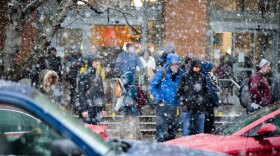On a Wednesday morning, 72-year-old John Simpson walked through an alley in downtown Olympia. He passed by a woman and two men when writing on the wall caught his attention and stopped him.
"You know what would really be nice?" Simpson asked one of the men. "And I don't mean to impose on you. You see that behind you on the wall? Can I get a photograph of you?"
Simpson interrupted what appeared to be a drug deal to ask his question. It’s tense at first but they said yes and posed for photos. Then Simpson asked if he can give them doughnuts.
This is just one example of how Simpson’s interactions go while taking pictures of unhoused people.
Simpson hopes to put a face to the homeless population in Olympia through his pictures. He’s not out here to pass judgment — he just wants decision makers to see the living conditions for some of the more than 31,000 people in the state without permanent housing.
Simpson is always looking for one thing when he takes a photograph.
"That person looking right back at me because if you’re the viewer, I want them looking at you," he said. "And then you tell them why you’re not willing to help. Why this country is delinquent in helping the homeless.”
Photography is not new to Simpson. He is a reporter for a military newspaper and was embedded eight times as a photographer in Afghanistan and Iraq. Before that, he taught history at Pierce College, served in the U.S. Air Force, and was a longtime city councilmember in Lakewood, Washington.
He started taking pictures of unhoused people a little more than a year and a half ago. He had been documenting graffiti artists when he found two men slumped over in an alley. He asked if they were alright and if they needed anything, and then he pulled out his camera.
"We have people, young people — these guys were maybe 18, 19 years old — barely hanging on on a subfreezing day in Olympia, Washington," Simpson said.

On this outing, Simpson wore tan pants, a gray polo and an old rain jacket. His chin is dotted with white hairs. He held a brown bag of doughnuts and had extras in his black backpack. He carried them because the people he photographs are often hungry.
Simpson’s photos are black and white because that’s how he sees the situation in Olympia.
"There is no question here — either we are going to fix this or we aren't," he said. "It's a black or white proposition that American society, that Olympia, Washington, has to come to grips with. This isn't — there's no half measures here."
Of course, it’s not that simple. Solving homelessness is a complicated problem. Drug addiction, mental health issues and the high cost of living are all factors that contribute to people living on the streets. It’s also one that the federal government, states and local governments are pouring lots of resources into trying to fix.
Still, Simpson said not enough is being done to put people into homes.
Darian Lightfoot, Olympia's director of Housing and Homeless Response, agreed.
“We, as in the country, the government, are not doing enough. I absolutely align with that sentiment,” she said.
There’s a number of ways the city is addressing homelessness.
Olympia has plans to bring roughly 550 affordable housing units online in the next four years. And in 2018, Olympia voters passed a tax that generates about $2 million annually for affordable housing units.
“We have evolved one of our tiny home villages into a workforce tiny home village, and the only requirement to be in the village is that you want to work full time,” Lightfoot said.
"If you’re the viewer, I want them looking at you, and then you tell them why you’re not willing to help."John Simpson, photographer
Lightfoot is proud of the work the city is doing, but said Olympia is limited in its resources and often has to jump through federal regulatory hoops to get projects done. She said addressing homelessness goes beyond state and local agencies.
“It's now everyone's responsibility in the city to find ways to address housing instability and homeless response," Lightfoot said. "And we're really putting that back to the community too, like we're passing all these missing [housing] middle laws — maybe an ADU on top of your garage is something that you'd be interested in, it's nationally affordable housing. Like, be in this with us. Maybe you're part of a religious community — do a food serve on Sunday. Like, how can everyone play a role?"
Lightfoot said she understands Simpson’s intent is to humanize the issue of homelessness.
“And connect with people and shine the light on people's neighbors suffering. I'm sure that that's it," she said. "And I think if, again, we have that culture of trying to highlight the issues and how we can work together, I think that we can compound all of our abilities, and we can see communal progress.”
Back outside, it doesn't take Simpson long to find someone he knows.
Patrick Wulff and his dog, Twilight, sat on a blanket in an alley. Wulff smoked a cigarette while he talked about Simpson.
"John's an awesome guy," Wulff said. "He comes down, takes pictures of us, gives us cigarettes and doughnuts. We have conversations about how homelessness is a joke.”
Wulff has been unhoused for 13 years. He said Simpson's work is important because it could help people better understand how difficult it is to live outside.
"People just think, oh we have food, we have blankets, we have socks — We're ok. No, we're not," he said. "We're out here dealing with people throwing s--- at us, trying to beat us up while we're sleeping. It's not really the life you want to live."
Simpson often compared the work he’s doing in Olympia to photographs of life in rural America taken in the 1930s during the Great Depression. The images are of poverty-stricken families living in make-shift homes, surviving dust storms and migration in search of work.
The photos helped spur people to take action. Simpson said he hopes his photos do the same.
“I can't change everything, but I can certainly, in a sense, join the ranks of those documentary photographers in the past,” he said.
Simpson’s photos are often published in The JOLT. They can also be seen on the websites for Social Documentary Network and Street Photography Magazine.
For Simpson, this work aligns with one of his core values.
“I have this belief that if you have been, in a sense, granted the ability to think critically, to speak well — maybe you should put it to service for people who can't," he said.
That same belief is what’s leading him to speak up for the unhoused population with his camera.










